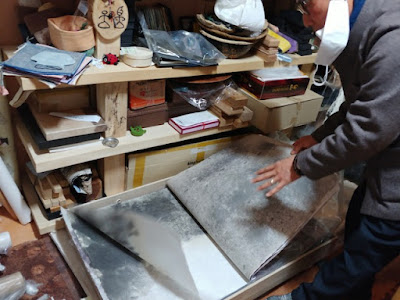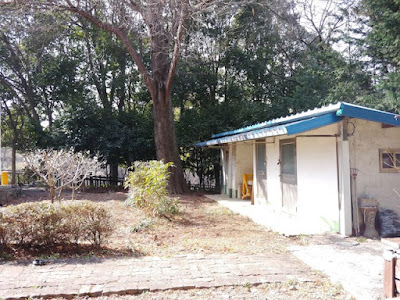Left: Dr. Jo Hyun-jin. Right: Dr. Lee Oh-kyu. These two powerhouses were my endlessly generous hosts in Jinju, and in this image are showing me the samples of hanji made for the first time by two people at once since way back when hanji was made this way. Mr. Shin Hyun-se, easily the best papermaker in the country, made these huge sheets with his current apprentice. Fingers crossed that I get to see them soon.
Dr. Jo has been working with hanji for 40 years and we both talked about how it was a shame that we weren't able to connect sooner. We had met briefly in 2014 but only now have been able to spend genuine time together. In his mid-60s, he has about 10x the energy that I do, and is easily the person who knows the most about hanji, from the small to big pictures, from on-the-ground and in-the-studio work than anyone else here.
He has spent years learning how to be able to dye hanji with natural dyes perfectly evenly. This is something that almost no one does, because it's hard. It's really, really hard. This is why you always see mottled dyed papers or paper "with character" because to get a large sheet one even color is extremely difficult. I know this, which is why I don't even try to do it. I leave that to the pros, even though in some sad ways, there are almost no pros. He also has spent enormous amounts of time, energy, and funds to figure out ways to use hanji in new and old ways. This is a light covered in hanji.
Of course he also dyes paper in dynamic ways, and has a whole separate space to do that work.
This is a lovely example of his dyed and textured and coated hanji. Because it's not enough to just get the paper to be a nice even color. It needs to be durable, so he uses joomchi techniques and has come up with his own method of coating and making hanji leather, which he turns into handbags, shoes, and a ton of other things.
Held up to the light. He is good about working and collaborating with other people, and I believe another artist did the bojagi work on this.
The garments are also made of hanji.
Dr. Jo knows tons of intangible cultural property holders. In this case, a fan maker. Dr. Jo dyes the hanji and then takes it to other people to use.
Black, especially natural black, is really hard to get on any handmade paper.
The lighting wasn't great but this is a fan made of taeji, hanji made with inclusions of fresh-water algae in the Spirogyra genus. It's hard to find these days but the paper is gorgeous. This taeji project is one that Dr. Lee has been working on through his work at the National Institute of Forest Science as a senior research scientist.
This tree has hung out for a long time at the institute, and I was able to visit on a beautiful day. It's warmer down south (the bus ride to Seoul from Jinju is 4 hours) so there were more blooms in general as well. Dr. Jo used to work here so he is familiar with all of the plants, so it was like visiting old friends. Dr. Lee has degrees in forest science and chemistry, and spent many years doing his graduate and doctoral work in Maine. He came upon hanji late in his career and found it shocking that so little research has been done about it in different realms, whether from a historical perspective or scientific. Fortunately, he has been able to work with Dr. Jo and they make an amazing team.
He and Dr. Jo walked me around the grounds, which of course are covered with trees of different types and I definitely could not keep track of them all. But it's my favorite kind of work, a nature walk. I remember doing them as a child in school, but obviously I am not great at observation because I still can't tell what poison ivy looks like. This is not the original building, but the general site of Dr. Jo's former hanji research studio. Opposite are trees that you'd use to make hanji. I may do a separate post on this but OMG. I was in shock when I saw that the institute has a GINORMOUS hanji studio that is laying empty. Two or more of everything (here are the knife beaters, known to some as naginata machines), in an incredibly well-equipped lab. I just could not believe it. As someone who has spent the greater part of her professional life building hanji studios or trying to get existing spaces to accommodate hanji making, this is like walking into heaven. Except that it's not being used. I wanted to scream. The joke was that I should come and use it. If only!
Dr. Jo was trying to show me how to differentiate different types of bamboo by the hairs coming out of the base of the leaves. This is not my forte but I still love attempting to learn.
They warned me that this is not even all of the bamboo on the institute grounds. It certainly was not but even this was so much more than I had been able to inspect.
Dr. Jo also pointed out this old tree that has been on the grounds for a very long time.
It's special because it is actually two trees that grew together into one!
Okay, back to Dr. Lee's enormous project: he is gathering paper mulberry trees from all over Korea, at least 45 different regions, to find out how much bast fiber each type/area produces. This is an exquisite combination of lab work and hanji folks because it requires everyone to work together while doing what they do best. In this batch is last year's haul, which meant harvesting, steaming, stripping, and scraping bark. While keeping each batch together, not mixing them, and weighing and keeping records at every step.
We're not talking about the stuff I do, like weighing on a baby scale. This project requires millions of dollars of lab equipment and space. Don't ask me about what these expensive machines do. Dr. Lee explained everything in each lab but I think my mind had already exploded by then and I was just trying to keep up taking notes and pictures while gawking behind my mask.
This is the biggest paper mulberry tree in Jinju, which Dr. Jo located and Dr. Lee got the funding to move. That was a giant and expensive project, because it was on school grounds growing in between a wall and a building, so the whole building had to be knocked down. It was pruned so that the tree doesn't have to try and send nutrients up right now because they want it to take root properly. There's an entire mechanism around it where under the plastic there is a band full of holes wrapped around the base so that the roots can poke out and go into the ground more easily. I'm not sure if you can tell, but at this point of my trip (my last evening), I wanted to collapse. I was very sick.
But I didn't want to give up my chance to see the huge bamboo forests that we didn't get to see on the prior day because the sun set. Of course it was raining on this day but it was still beautiful. Dr. Lee at this point insisted upon seeing me take pictures that I walk ahead of him so that I could get unobstructed images, but all I wanted to do was lag behind because I was so ill.
More about my illness later (I'm fine now, just trying to take it easy, which for those who know me is very hard) but my four days in Jinju were incredible! This is not even scratching the surface, but I wanted to try and post before I get swallowed up by the next thing. Meeting these two was a welcome surprise and the biggest gift, to be able to meet people who really get hanji and are actively working to keep it healthy, so early on in my trip.























1 comment:
Interesting. I want to meet him sometimes.
Post a Comment